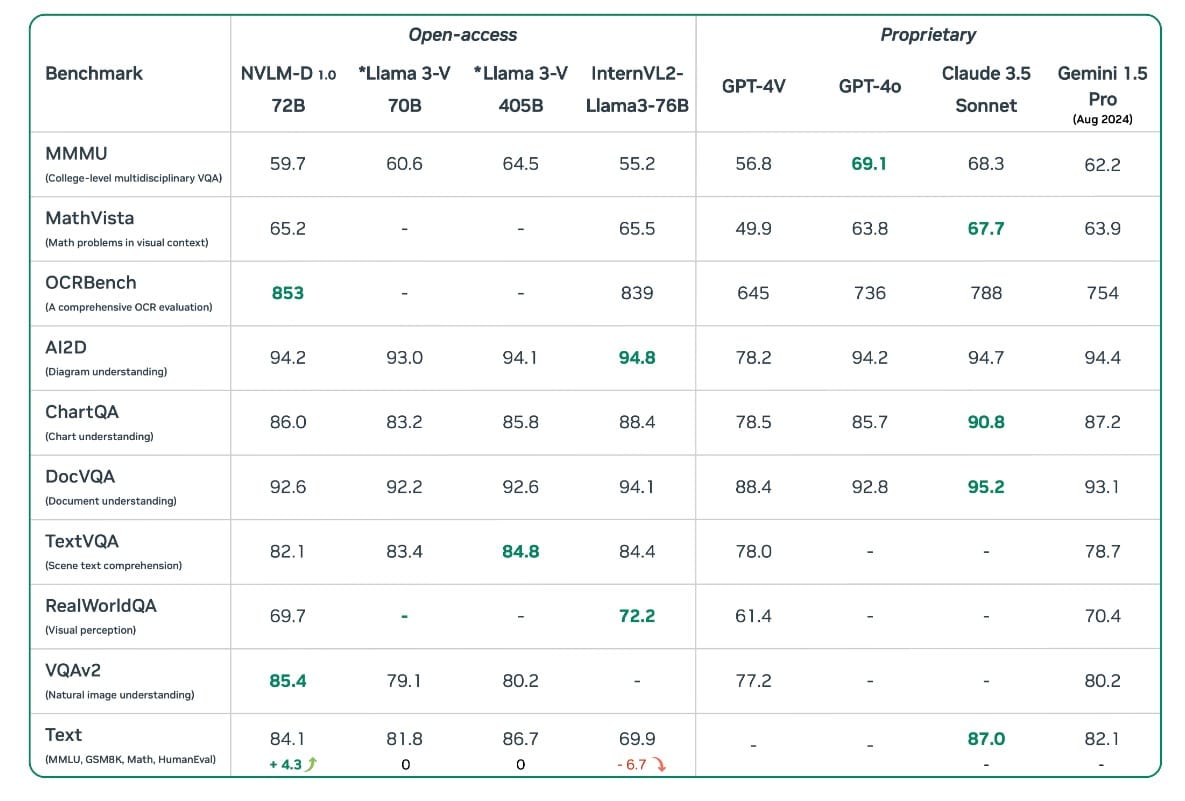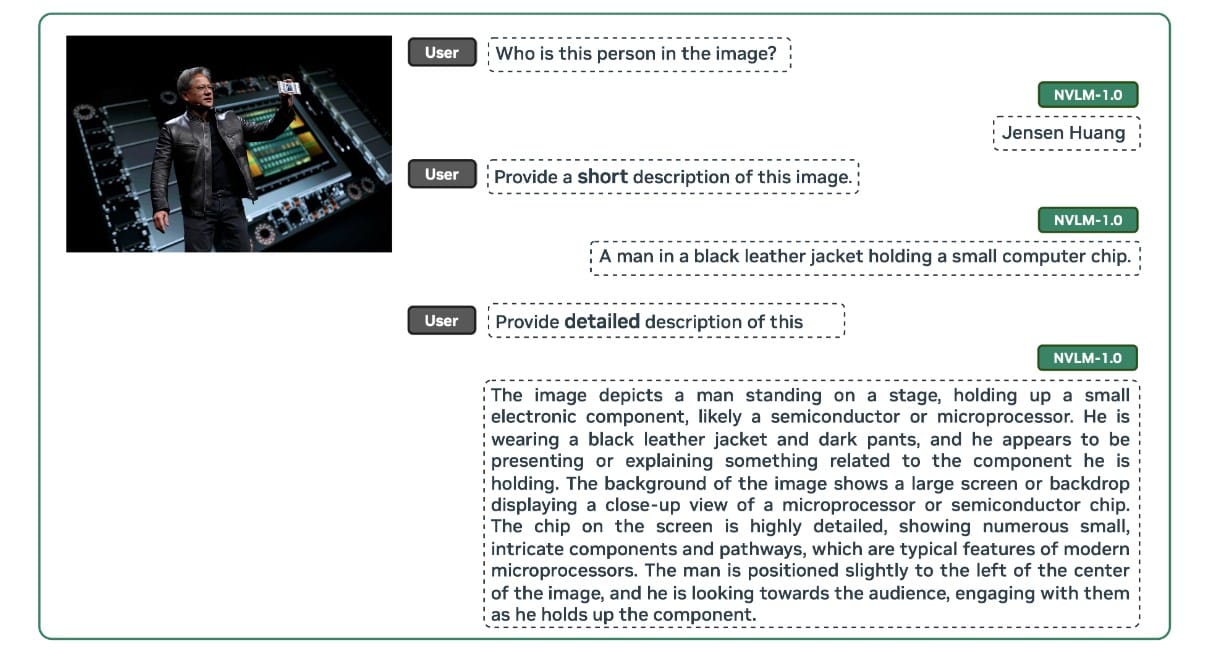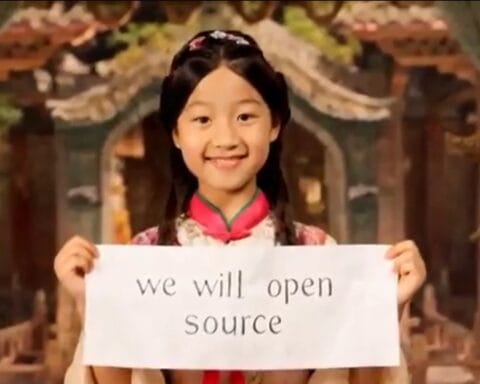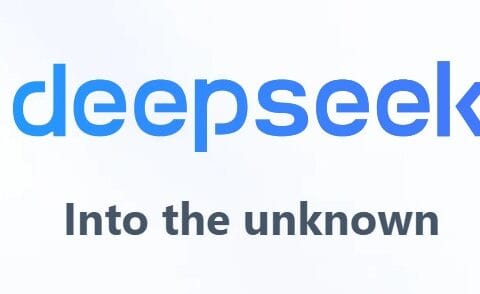Last Updated on October 4, 2024 11:26 am by Laszlo Szabo / NowadAIs | Published on October 4, 2024 by Laszlo Szabo / NowadAIs
Nvidia Drops NVLM-D-72B AI Bomb: 72 Billion Reasons OpenAI Should Be Scared – Key Notes
- Nvidia released NVLM-D-72B as an open-source AI model, making advanced AI technology freely available to developers worldwide
- The model contains 72 billion parameters and outperforms many proprietary models in both vision-language and text-only tasks
- While free to use, the model requires substantial computational resources, potentially limiting its immediate accessibility
The AI Arms Race Just Got Wild
In a move that’s sending shockwaves through Silicon Valley’s ivory towers, Nvidia just crashed the AI party with all the subtlety of a bull in a china shop. The tech heavyweight has unveiled NVLM-D-72B, a monster of an AI model that’s not just matching the industry’s biggest players – it’s beating them at their own game. And here’s the kicker: they’re giving it away for free.
You read that right. While companies like OpenAI and Anthropic keep their AI models locked up tighter than Fort Knox, Nvidia’s basically throwing a “take our code, please!” party. It’s like showing up to a black-tie dinner in jeans and a t-shirt – and somehow pulling it off.
Meet the Beast: 72 Billion Reasons to Pay Attention
Let’s talk numbers, because in this case, size definitely matters. NVLM-D-72B packs a whopping 72 billion parameters – that’s like having 72 billion tiny brain cells all working together. For the tech-curious but jargon-averse among us, imagine cramming the combined brainpower of a thousand chess grandmasters into a single system, then teaching it to not just play chess, but also write poetry, analyze photos, and solve complex math problems.
This isn’t just another AI model joining the party – it’s the gatecrasher that shows up with better moves than everyone else. In test after test, NVLM-D-72B isn’t just keeping up with the industry’s heavy hitters; it’s leaving them in the dust. We’re talking about scores that would make any tech CEO spill their kombucha.
The Secret Sauce: It’s All in the Design
Remember that kid in school who seemed to excel at everything without breaking a sweat? That’s NVLM-D-72B in the AI world. Nvidia’s engineers didn’t just build another AI – they reimagined how these systems should work from the ground up.
The magic lies in what they’re calling a “1-D tile-tagging design” for handling images. If that sounds like techno-babble, think of it this way: while other AI systems look at pictures the way we humans do – all at once – NVLM-D-72B breaks them down into tiny pieces, like solving a jigsaw puzzle one piece at a time. It sounds slower, but somehow it’s working better than anything else out there.
The Numbers Don’t Lie

Let’s get down to the nitty-gritty, because the scorecard on this thing is absolutely bonkers. In vision-language tasks (think: looking at pictures and understanding what’s in them), NVLM-D-72B is posting numbers that would make a statistician weak in the knees:
– 59.7 on MMMU (think of it as the SATs for AI)
– 65.2 on MathVista (solving math problems from pictures)
– A jaw-dropping 853 on OCRBench (reading text from images)
But here’s where it gets really interesting: this AI isn’t just good at handling pictures and text together – it’s actually better at text-only tasks than models specifically designed for that purpose. It’s like finding out your star quarterback is also the best chess player in the school.
Why This is a Big Deal (Like, Really Big)
Here’s where things get spicy. By making NVLM-D-72B open-source, Nvidia just handed the keys to the kingdom to… well, everyone. It’s like they’ve taken the secret recipe for Coca-Cola and posted it on the internet.
For the tech giants who’ve built their empires on proprietary AI models, this is the equivalent of watching someone set up a free lemonade stand right outside your premium juice bar. Sure, your juice might be organic and cold-pressed, but free is free.
The David and Goliath Effect
This move is a huge option for the little guys in tech. Think about it: until now, if you wanted to compete in the AI space, you needed deep pockets – we’re talking billions-deep. Now? Anyone with enough technical know-how can take NVLM-D-72B and build something amazing with it.
It’s like Nvidia just armed every tech David out there with a high-powered slingshot. The Goliaths of Silicon Valley might still have their advantages, but the playing field just got a lot more level.
The Catch (Because There’s Always a Catch)

Before you start planning your AI startup empire, there’s one tiny detail worth mentioning: running this beast requires some serious hardware. It’s like being handed the keys to a Formula 1 car – awesome, but good luck finding somewhere to drive it.
The computational power needed to run NVLM-D-72B at full capacity isn’t something you’ll find in your average laptop. We’re talking about hardware setups that could make even seasoned tech professionals whistle through their teeth at the cost.
## The Ethics Question
Let’s address the elephant in the room: with great power comes great responsibility, and NVLM-D-72B is packing more power than a nuclear power plant. The potential for misuse – think deepfakes, misinformation campaigns, or automated spam on steroids – is enough to keep ethics professors up at night.
Nvidia’s aware of this, of course. They’ve put some guardrails in place, restricting the model’s use to research purposes. But let’s be real: once something’s out in the wild, controlling how it’s used becomes about as easy as herding cats.
What This Means for the Future
Here’s where things get really interesting. Nvidia’s move could trigger a domino effect in the AI industry. When one of the biggest players in tech decides to go open-source with something this powerful, it puts pressure on everyone else to follow suit.
We might be looking at the beginning of an AI renaissance, where innovation isn’t locked behind corporate doors but happens out in the open, with researchers and developers worldwide building on each other’s work.
The Industry Response
The response from other tech giants has been telling. Picture a high school cafeteria where the cool kids’ table suddenly realizes anyone can sit there. There’s been a lot of carefully worded statements about “interesting developments” and “watching the space closely,” but reading between the lines, it’s clear: they’re sweating.
And they should be. NVLM-D-72B isn’t just matching their proprietary models – it’s beating them in several key areas. It’s like watching a free-to-play game top the charts while premium games gather dust.
What’s Next?
The genie’s out of the bottle, and there’s no putting it back. In the coming months, we’re likely to see an explosion of applications and innovations built on top of NVLM-D-72B. Some will be groundbreaking, some will be terrible, and most will be somewhere in between.
But the real story here isn’t just about one AI model – it’s about what happens when you take something that was previously exclusive and make it available to everyone. It’s about democratizing technology that could shape the future of everything from healthcare to education.
Welcome to the people’s AI revolution. Nvidia just fired the first shot, and the echo is going to be heard for years to come.
Descriptions
- Parameters: The basic units of knowledge in an AI model, similar to neurons in a brain. More parameters generally mean the model can handle more complex tasks.
- Open-source: Software that’s freely available for anyone to use, modify, and distribute. Think of it like a public recipe that anyone can cook with and modify.
- Vision-language tasks: AI jobs that involve both understanding images and text together, like describing what’s in a photo or answering questions about an image.
- MMMU (Multimodal Machine Understanding): A standardized test for AI models that measures how well they understand and process different types of information together.
- OCRBench: A test that measures how accurately AI can read and understand text from images, like scanning documents or reading street signs.
- MathVista: A test that evaluates how well AI can solve math problems presented in visual form, like graphs or diagrams.
- 1-D tile-tagging design: Nvidia’s method for processing images by breaking them into smaller pieces, like solving a puzzle one piece at a time instead of looking at the whole picture at once.
- Computational power: The processing capability needed to run AI models, usually measured in terms of specialized hardware requirements.
Frequently Asked Questions
- Q: What makes Nvidia NVLM-D-72B different from other AI models? A: Unlike most advanced AI models that are kept private, NVLM-D-72B is open-source and free for anyone to use. It also uses a unique approach to processing images called 1-D tile-tagging, which helps it outperform many proprietary models in both visual and text tasks.
- Q: Can anyone run Nvidia NVLM-D-72B on their personal computer? A: Running NVLM-D-72B requires specialized hardware with significant computational power. While the model is free, the hardware needed to run it effectively can be quite expensive, making it more suitable for organizations with access to proper computing resources.
- Q: What are the main applications of Nvidia NVLM-D-72B? A: NVLM-D-72B can handle a wide range of tasks, from analyzing images and solving math problems to reading text from pictures and understanding complex visual-text relationships. Its open-source nature means developers can adapt it for specific uses in fields like healthcare, education, and research.
- Q: How does Nvidia NVLM-D-72B compare to other leading AI models? A: NVLM-D-72B matches or exceeds the performance of many proprietary models in both vision-language and text-only tasks. Its benchmark scores, particularly in areas like OCRBench and MathVista, show it competing effectively with industry leaders.
- Q: What safeguards does Nvidia NVLM-D-72B have against misuse? A: Nvidia has implemented research-only restrictions on NVLM-D-72B’s use and included various safety measures. However, as with any open-source technology, controlling its use after release presents significant challenges.








